Epic 2023 Monday conference notes
I’m back at EPIC! This is one of my favourite conferences and it’s happening in Chicago this year.

I’ll try to take live notes as I have in previous years. Here are my notes from EPIC 2022 2021, 2018 and 2017. Here are my notes for Tuesday, day 2 of EPIC 2023, and notes for Wednesday.
Keynote: Folded Map: Disrupting Chicago’s Friction through Art
Tonika is a photographer, artist and life-long resident of Chicago’s Englewood neighborhood. Her work reveals injustices in real estate and land use practices and encourages us to create positive change. Her Folded Map project visually investigates disparities among segregated Chicagoans while bringing them together for conversation. She’s been named a Chicagoan of the Year by Chicago Magazine, with previous exhibitions at the Museum of Contemporary Art, the Chicago Cultural Center, and more.
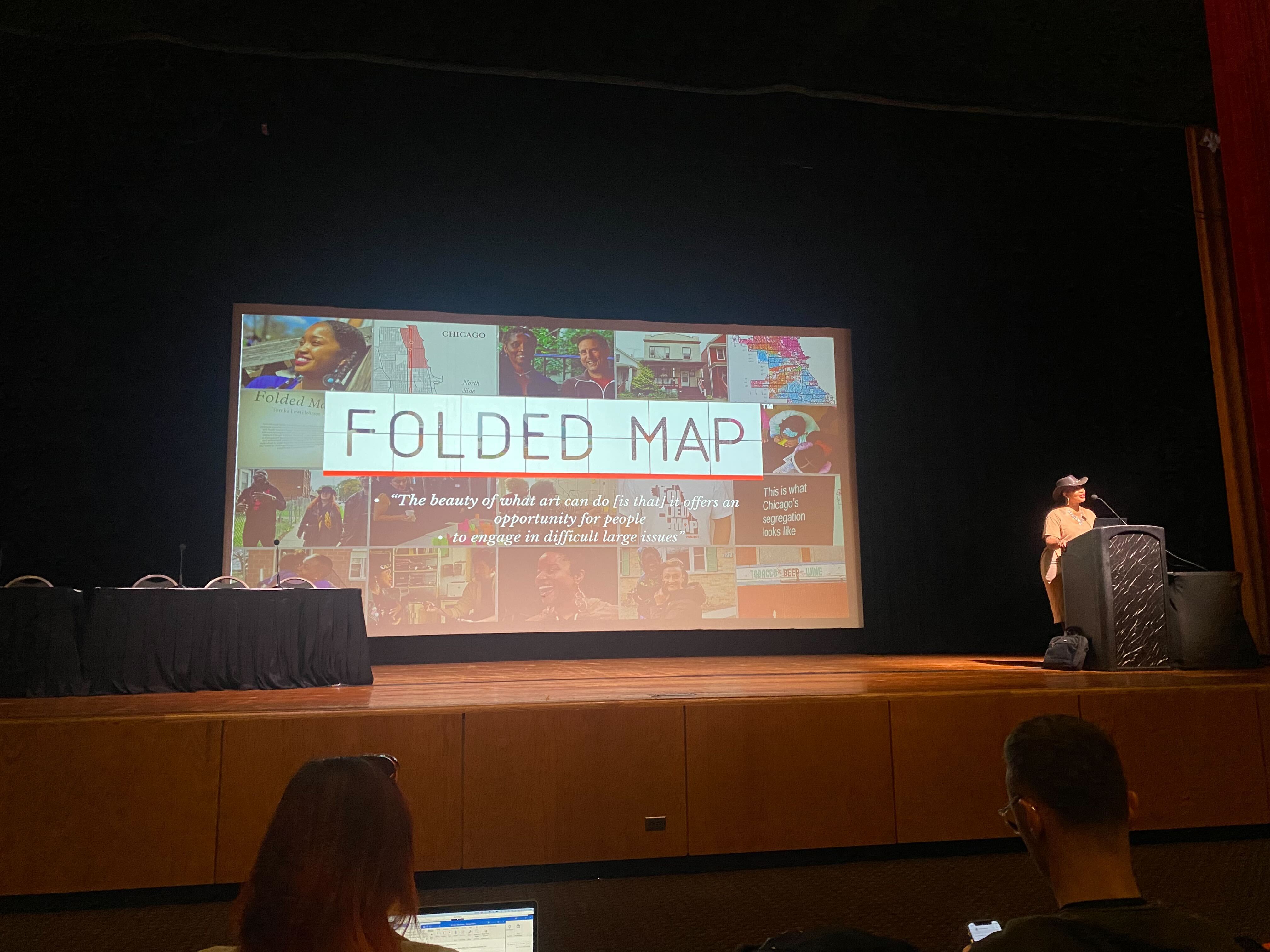
Folded map - matches up residents on north and sotuh side of the city that are equidistant from the city centre, ie 6720 N Ashland and 6720 S Ashland. “Map Twins”
The legacy of racism is with us today in the current value of homes in Black neighborhoods

Pink dots = white, cyan = black, green = asian, yellow = latino
Greater Englewood home ownership rate is 30% becuase of land sale contracts - 596 greater englewood homes sold on land sale contracts
Imagine what greatere englewood could be today if people owned thier homes.
Inequity for sale project - installed 13 300lb concrete-based land markers at the addresses where houses were stolen. two of those were damaged/stolen.
unBlocked Englewood project - What does public art actually look like? how can you transform and beautify a disadvantaged neighborhood when the people living there are struggling with basic living needs? Applied for a 500k grant (got 250k) to give to home owners for home repairs. Repairs to roof and structural damage enabled homewoners for federal free weatherization programmes.
“You can’t do any of these creative placemaking projects in these places when people’s homes are disinvested.”
Created Folded Map action kit
Constituting Community
The Transformative Power of Friction: Inclusive Community Center-ed Visioning in Manhattan’s Chinatown
Paper by Megan Marini, 3x3
how to shift and disrupt power structures in participatory design
going to talk specifically about building at 70 Mulberry in Manhattan’s Chinatown
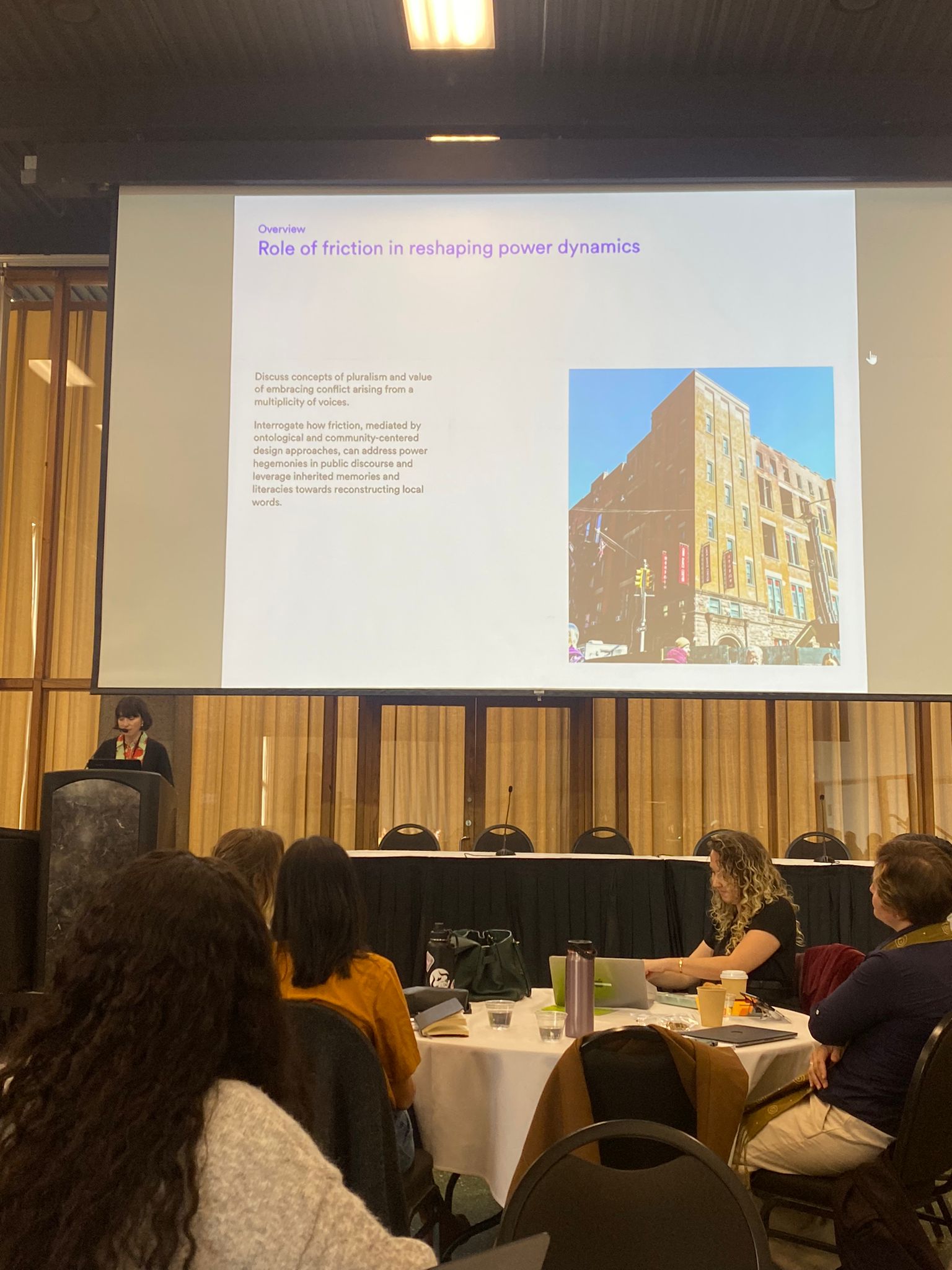
“how we can move towards autonomous communities”
70 Mulberry - orginally built as elementary school. many came to see their school as sanctuary. in 70s, became a community center and home to community-based organizations.
as of 2020, owned by NYC. big fire broke out. NYC committed $80m in funding to redevelop 70 Mulberry St.
“Root shock” - term coined in urban renewal re: upheaval of communities through urban renewal
started to see power hegemonies - friction between experts/bureaucracies and lived experiences; friction between different groups of communities.
drew from “tools for conviviality” Ivan Illich - created an ontological and community-centered design approach
Dangers of partcicpatory design: Illusion of inclusion - glossing over voices who have not dominated our understanding of truth Ladder of participation - Sherry Arnstein - participation without redistribution of power is empty and frustrating porcess for the powerless. i.e. participatory processes used to manipulated gruops
In Search of Cultural Entropy: A Call for New Frameworks of Analysis (PechaKucha)
Gunes Kocabag, Margin Innovation, Outsight International (Presenter)
What does local even mean in our contemporary world? New tech increasingly closed distance between different places and people MTV generation–>global village culture around topics i.e. kpop, anime, etc
But while we see increasing homogenization of culture across geographic boundaires, we also see fragmentation into sub-groups
entropy: the measure of disorder
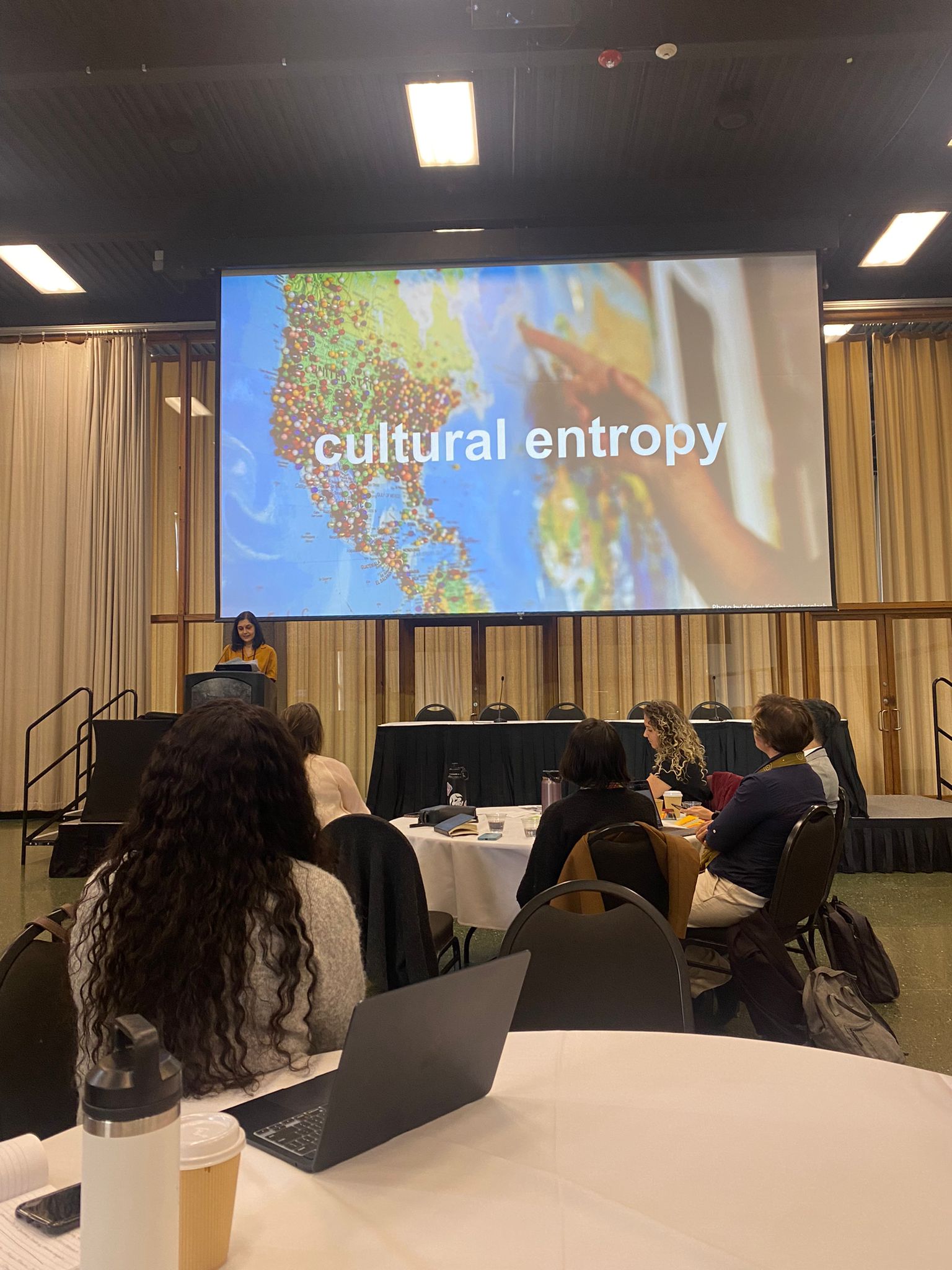
The order of time - carlo rovelli: the reason we perceive increasing entropy is because we have preconcieved ideas of order and disorder.
There is order in all disorder, just depends on what lens we use to look at it
Cultures are as locla and as unique as they’ve always been. we need a new framework for thinking about it.
Navigating Adoption by Global South Users: The Case of Wikimedia Volunteers (Case Study)
Camille Kramer Courbariaux, YUX (Presenter) Sasha Oseadeyo Ofori, YUX (Presenter) Kalama Hafisou, YUX
Wikipedia community - not just people editing entries, but also hosting edit-a-thons. noticed that these editathons weren’t being organized as much in global south. wanted to explore not just what their community is doing but also what other communities are doing that’s successful in Africa
Identified 4 communities 4 counties.
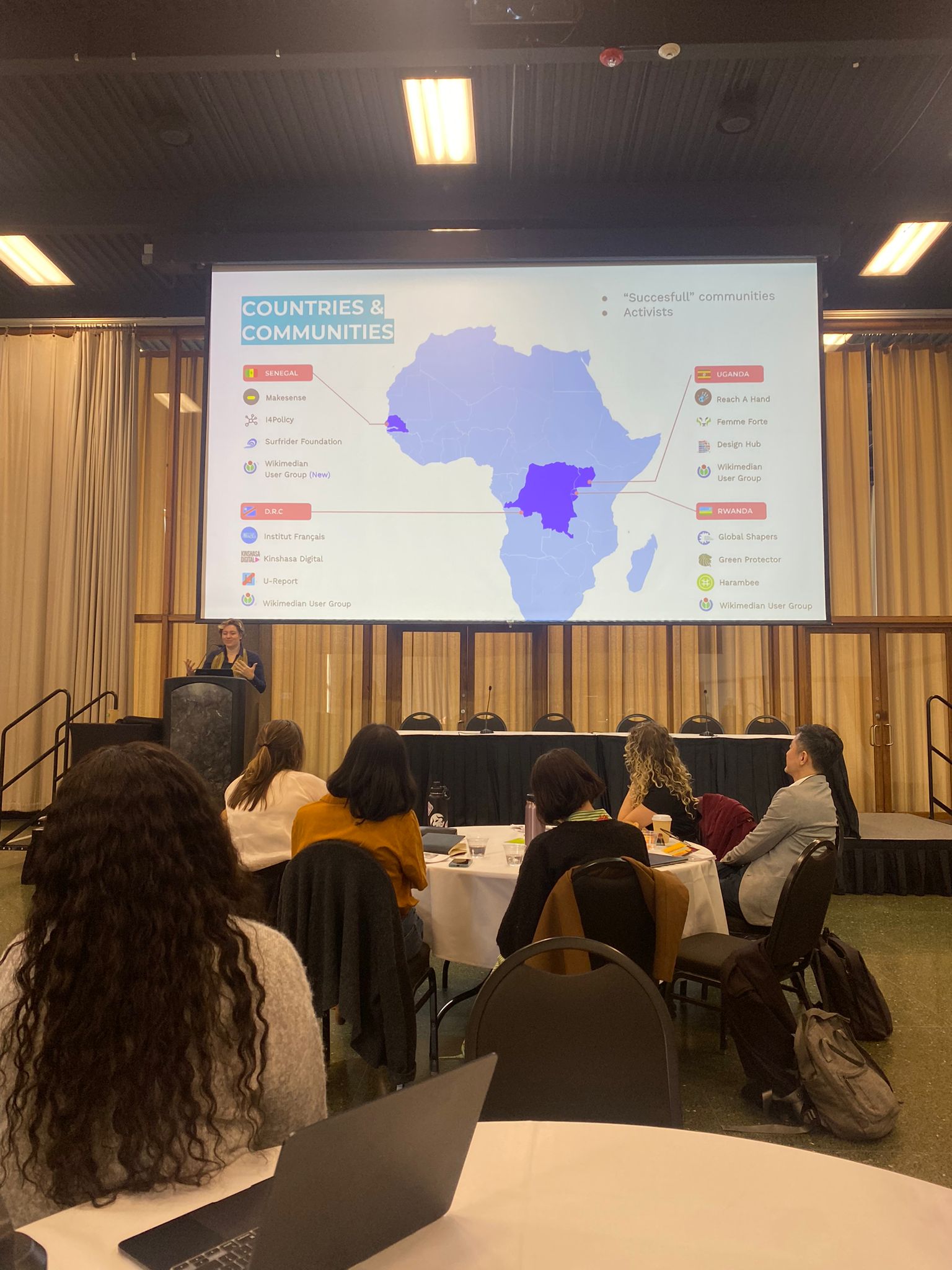
research revealed friction between western assumptions and reality. The biggest one is that motiviation for volunteering is two-fold, instead of purely altruistic (true for wikipedians in global north who are mostly retirees).
Second friction was around assumption that tools and tech were the challenge. instead, organizing is peopel-first activity and steps taking to improve tech were not the ones needed, or helping solve the right problems.
The assumption that wikipedia is a fair and objective source of information is also not the case - existing rules and structures for vetting wikipedia info disadvantages global south.
Why it’s important to have local researchers:
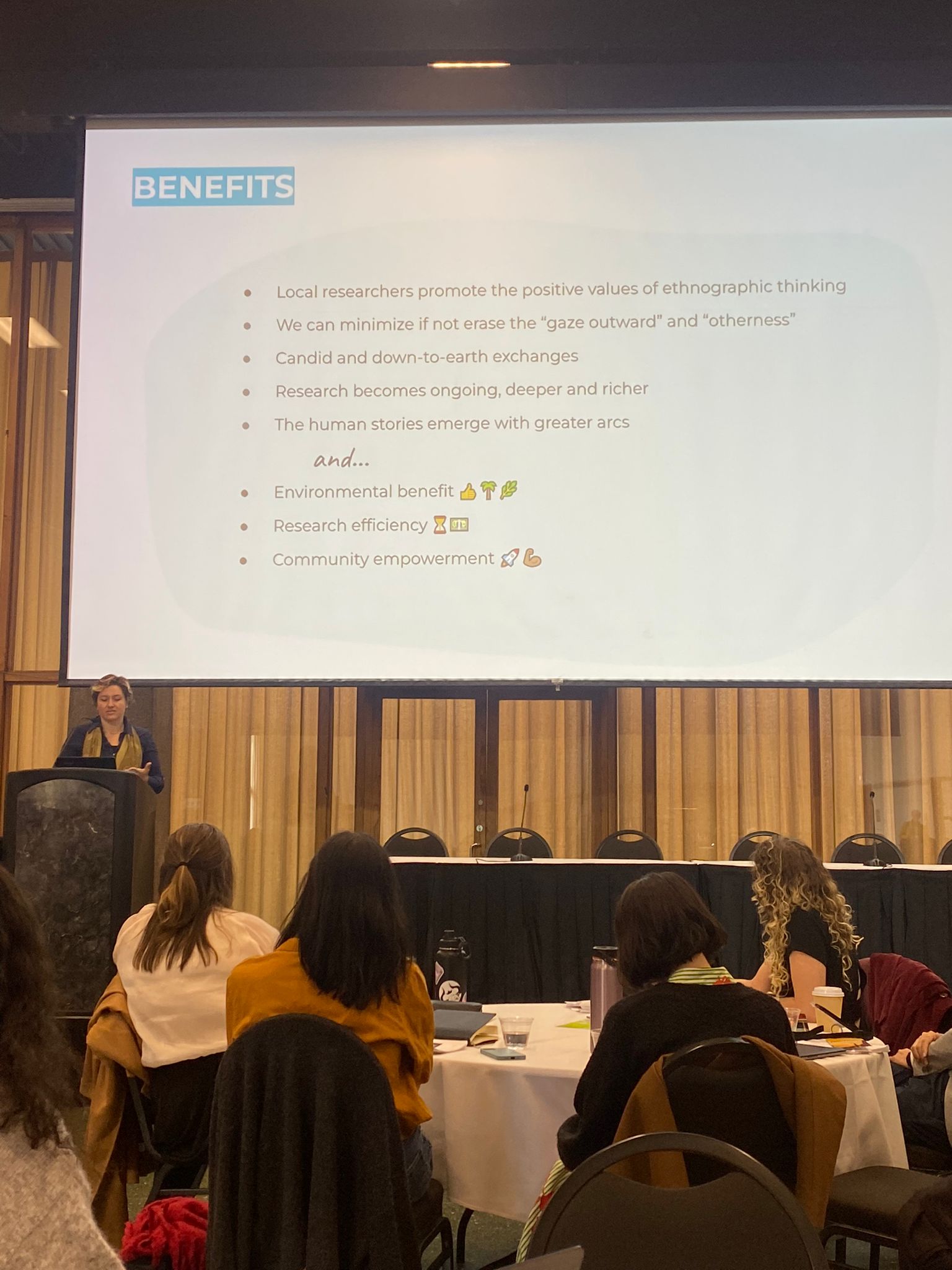
In Pursuit of Authenticity: Commodified Community, Curated Experience, and Fandom (Paper)
Logan McLaughlin, SpaceTime Strategies (Presenter)
SpaceTime Strategies - white label events company

Authenticity - we know it when we see it.
But in corporate setting, authenitcitiy is defined by outcomes.

People sees through the ad speak.
Fandom convention, meet-up, events etc goes back ~a century.
There are community-organised cons, but now have, with PAX, NYCC, etc, increasingly happens because of/through corporate sponsorship; big event brands bought out by trade show companies and run like trade shows.
Chairs! Gaming chairs went from not existing as a category
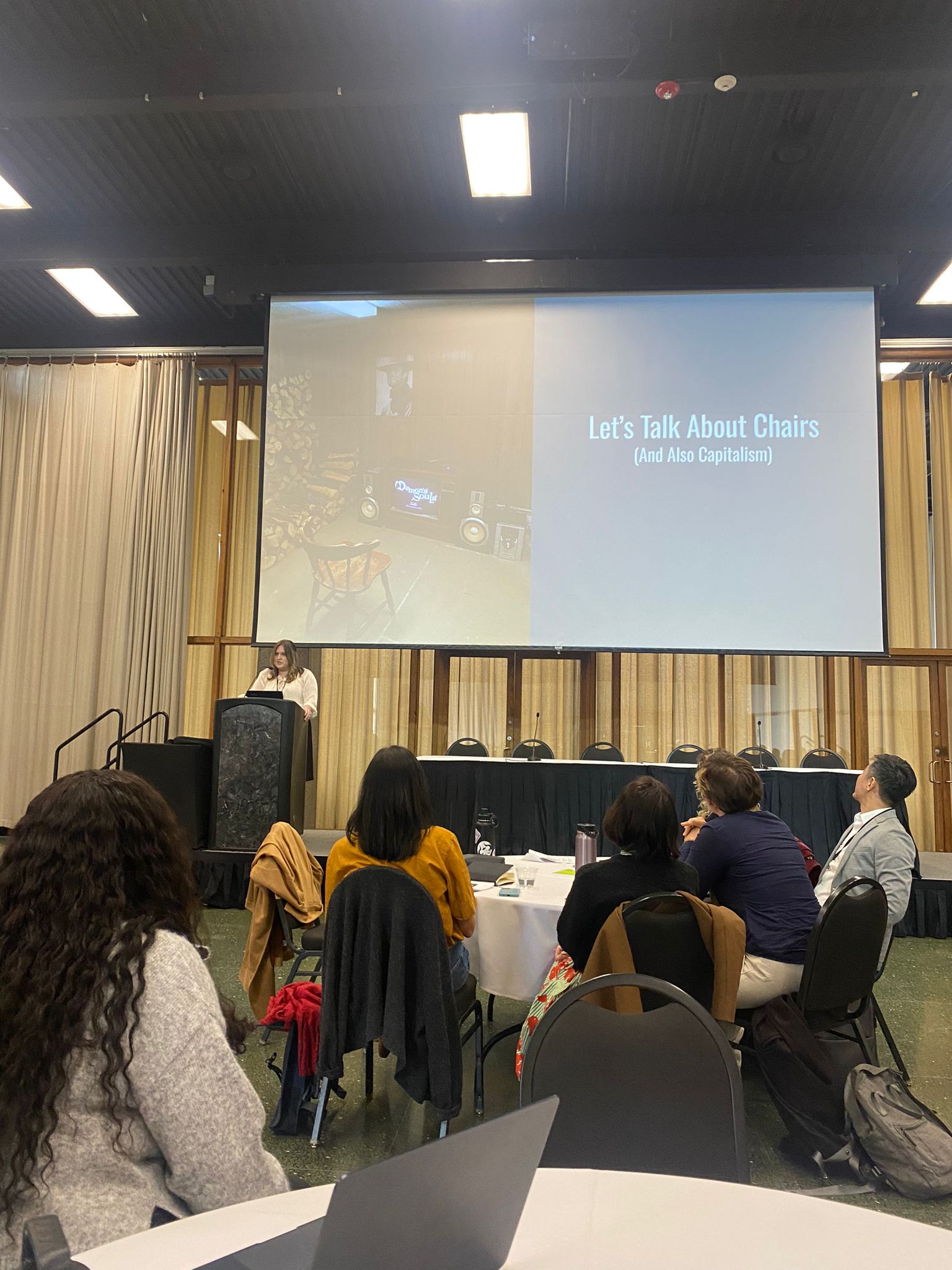
to a specific product:
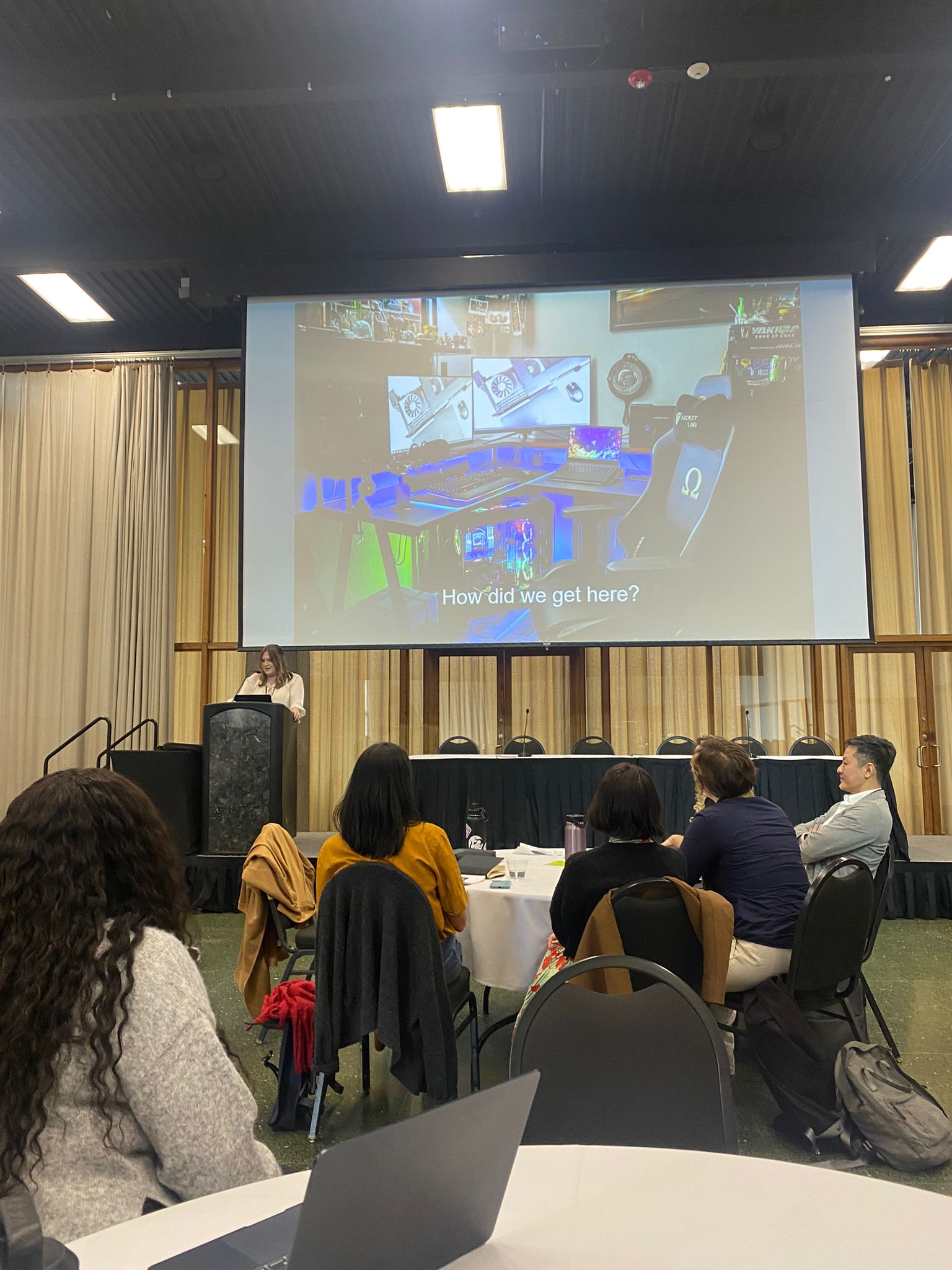
demand created through influencer marketing
and also through marketing at events - increasingly dealing with non-endemic brands, i.e. DoorDash, Shell, etc
Companies increasingly try to dictate what is ‘authentic’ and exert creative confrol; creates friction.c
Chevron and Shell both at Twitch Con. Also the navy. Their sponsorship has impact on the space and scheduling
white lable companies/activiation designers stand as negotiatiors between comapnies’ need for extraction and peopel wanting to enjoy things
What authenticity should be:
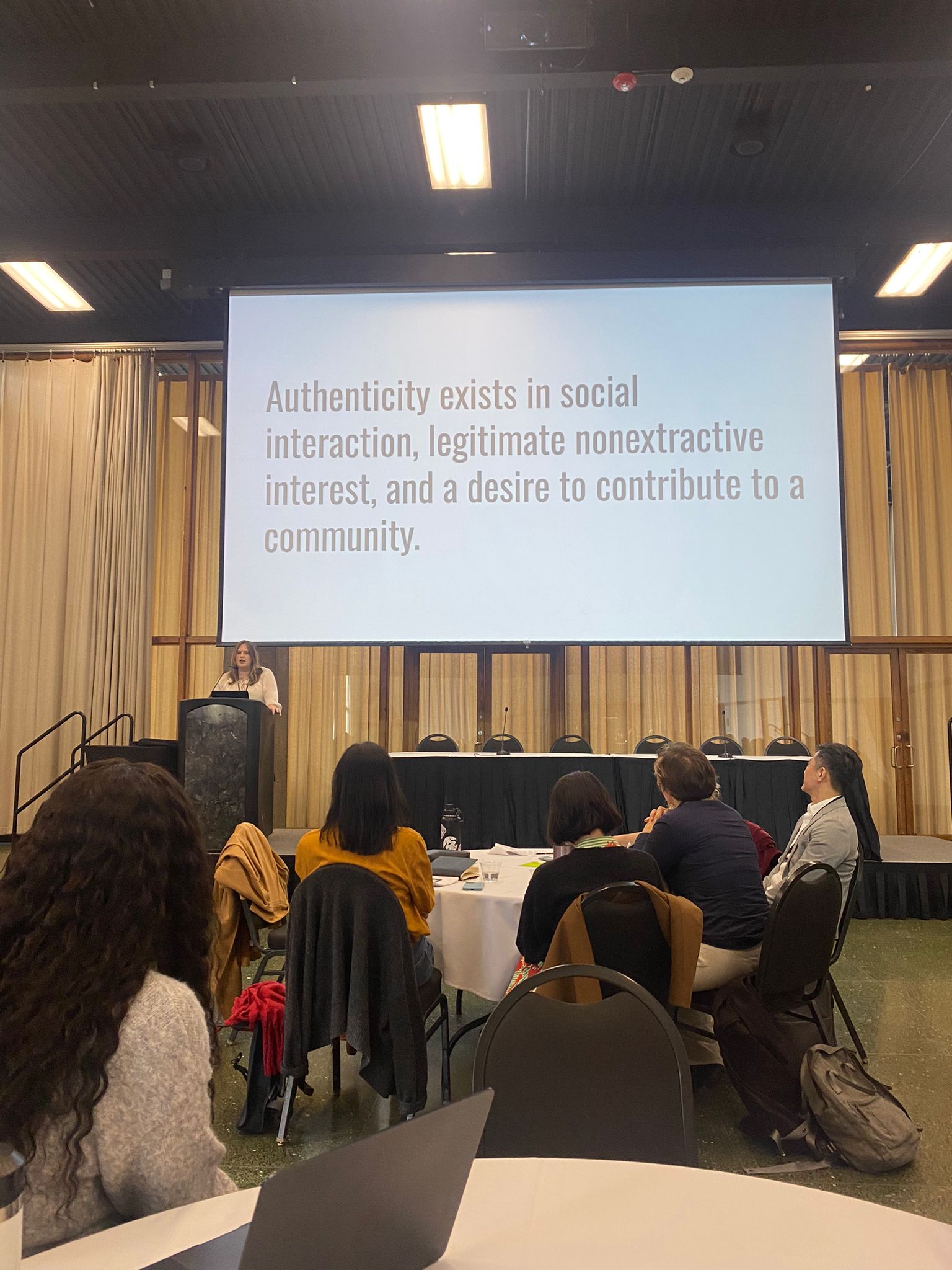
Intergenerational Living: Thai Cultural Frictions and Taboos in Changing Times (Case Study)
Adisorn Supawatanakul, Teak Research Co., Ltd (Presenter) Piyathep Tanmahasmut, Teak Research Co., Ltd
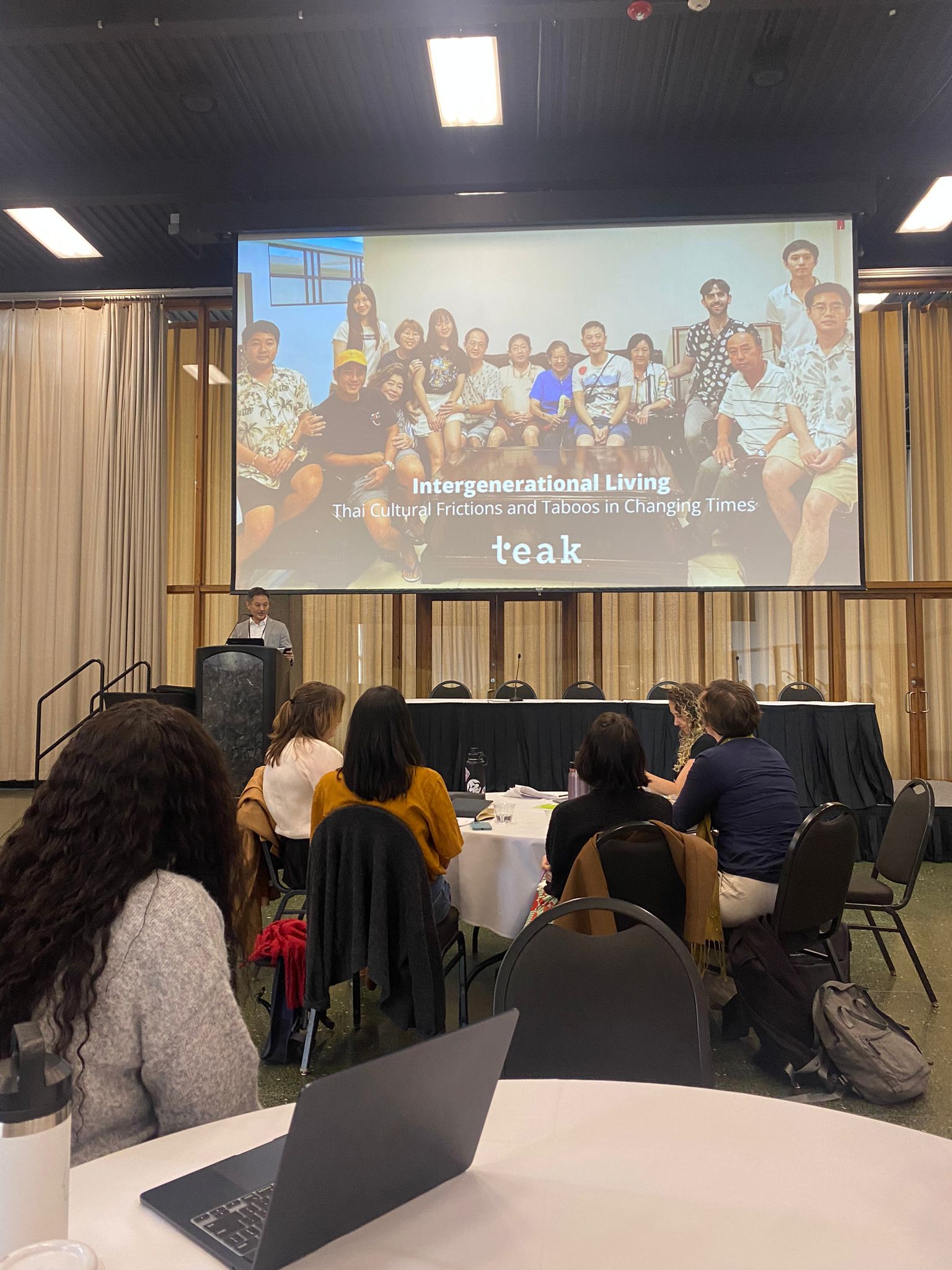
Case study for client building multigenerational real estate development called Mulberry Grove
Several frictions encountered.
- Cultural Taboo: intergen living is common but very little is discussed about family dynamics and friction points; talking about difficulties seen as shameful to family.
Dealt with that through holding individual interviews separate from the group interviews. Also did co-creation interviews.
- Family Dynamics intergen living is a traditional practice but family dynamics in thailand are changing with the times.
lifestyles are changing; lack of personal space and growing desire for privacy; also tensions from shared ownership. All of these fed into design implications:
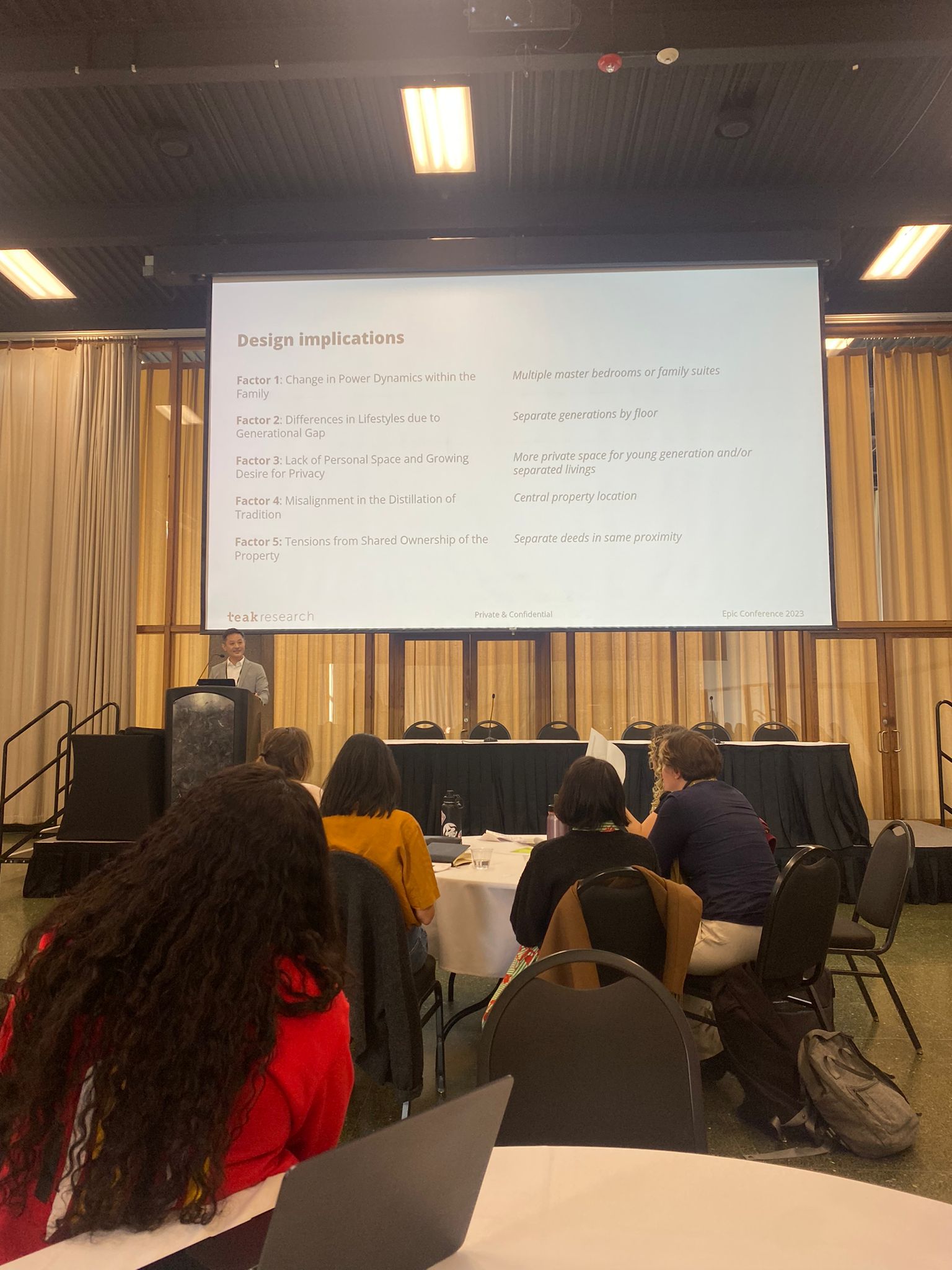
Anthro x Journo: The Value of Ethnography for Solving Modern Journalistic Challenges (PechaKucha)
Emily Kennedy, Writer (Presenter)
uses ethnographic practices in journalism
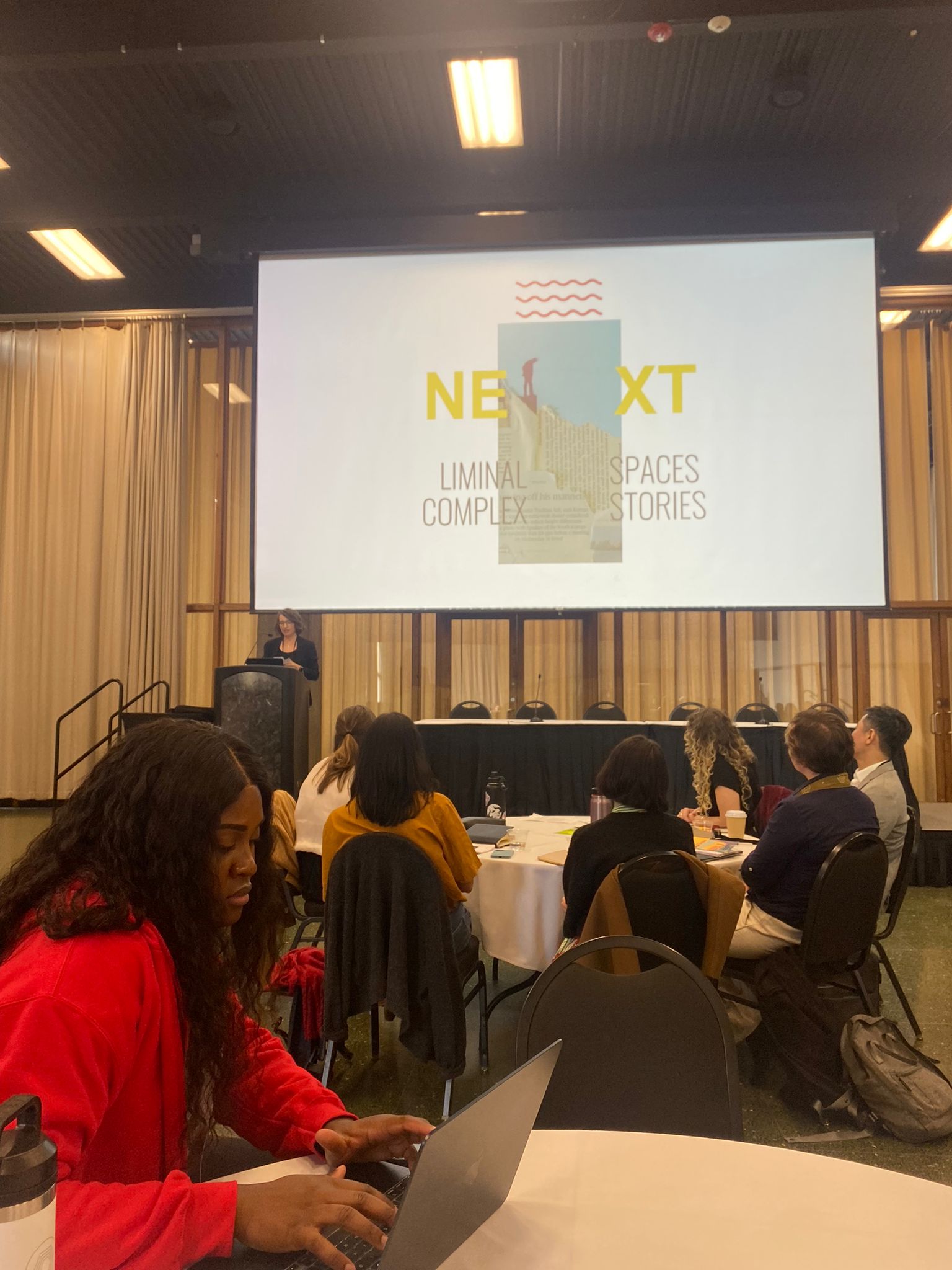
Ethnographic methods can help solve journalism’s challenges
gaining trust of a group to tell their story is where ethnography shines
Journalism can view society as a process (pace Victor Turner and the Social Drama)
and therefore focus on liminal spaces
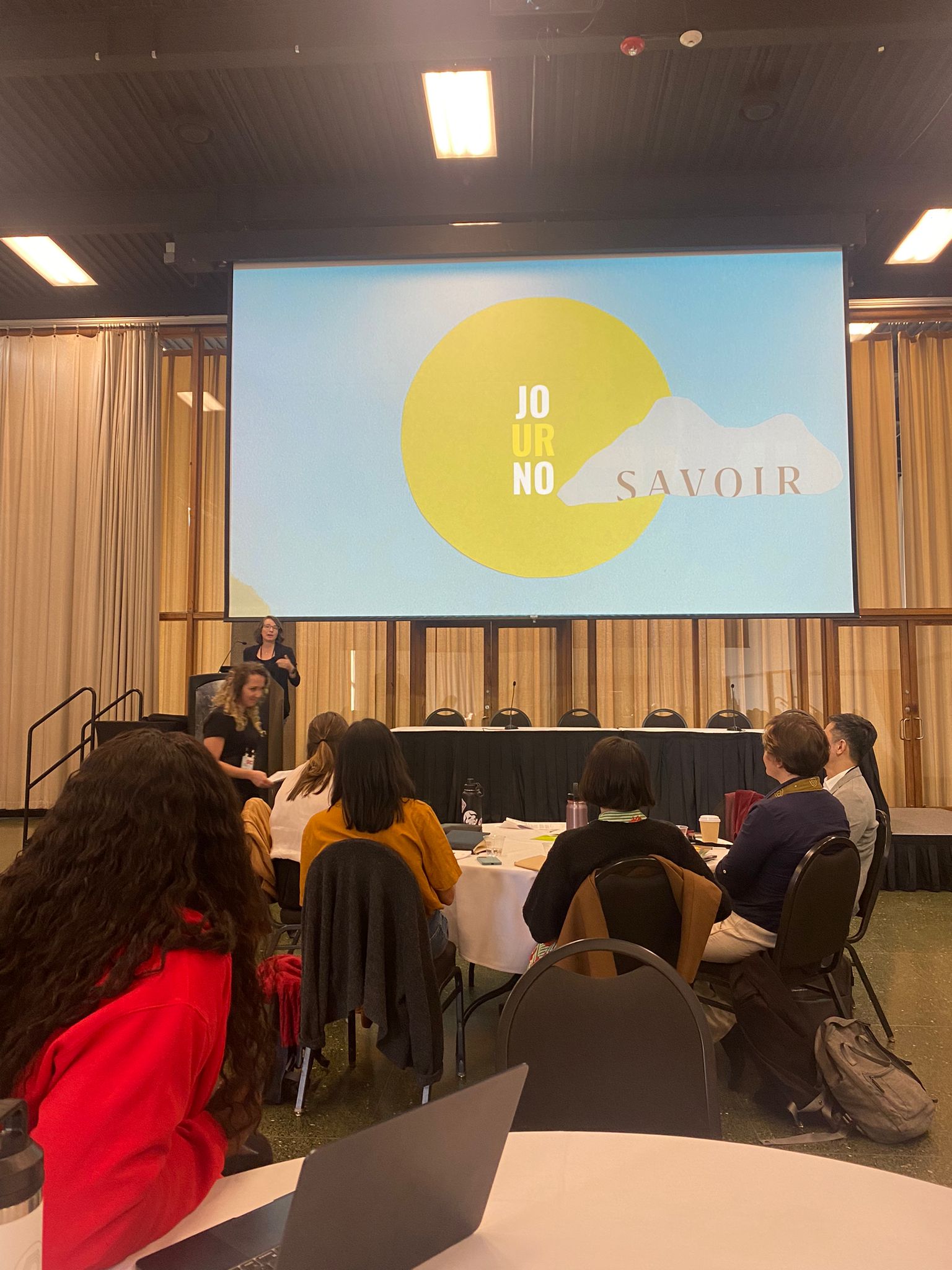
The difference between journalism sources and ethnography’s informants is the difference between them.
Both ethnographer and journalist face the same challenge of not being extractive in their engagement.
The verfication of facts is too limiting.
Resource for helping to bring a more anthropological approach to journalism: AnthroJourno.org
Friction to the Future!
Grounded Models: The Future of Sensemaking in a World of Generative AI (Paper)
Tom Hoy, Stripe Partners (Presenter) Iman Munire Bilal, Stripe Partners (Presenter) Zoe Liou, Stripe Partners
GenAI has arrived for researchers: products that integrate AI as small widget that you can use or discard, to more disruptive uses such as Synthetic Users
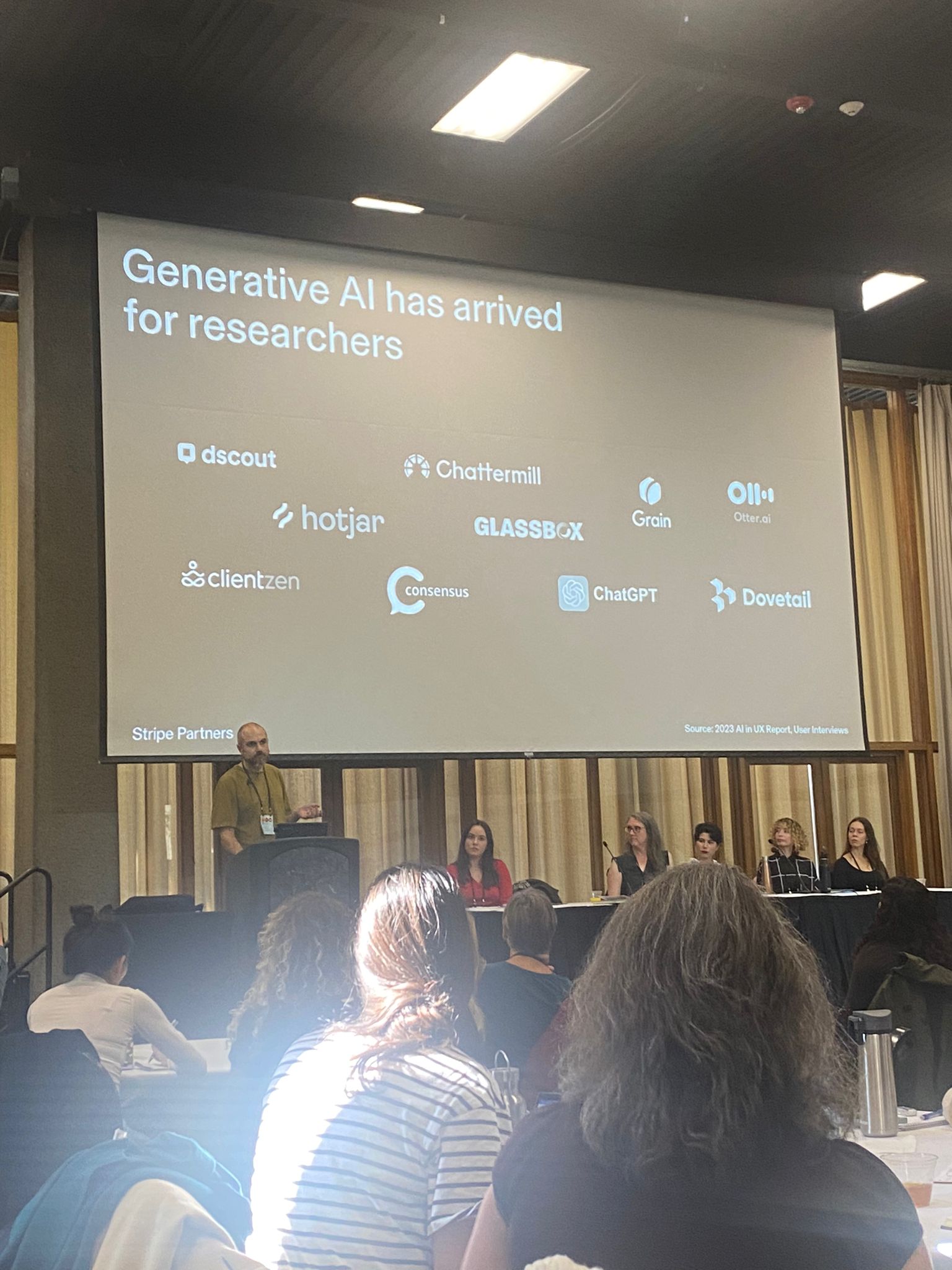
What do these new technologies mean for us, in reality?
15 experiments on 4 client projects over 18 months
new capabilities: more accessible interfaces, better understanding of laungauge, bigger memory.
Used NLP to understand patient sentiment towards a new treatment
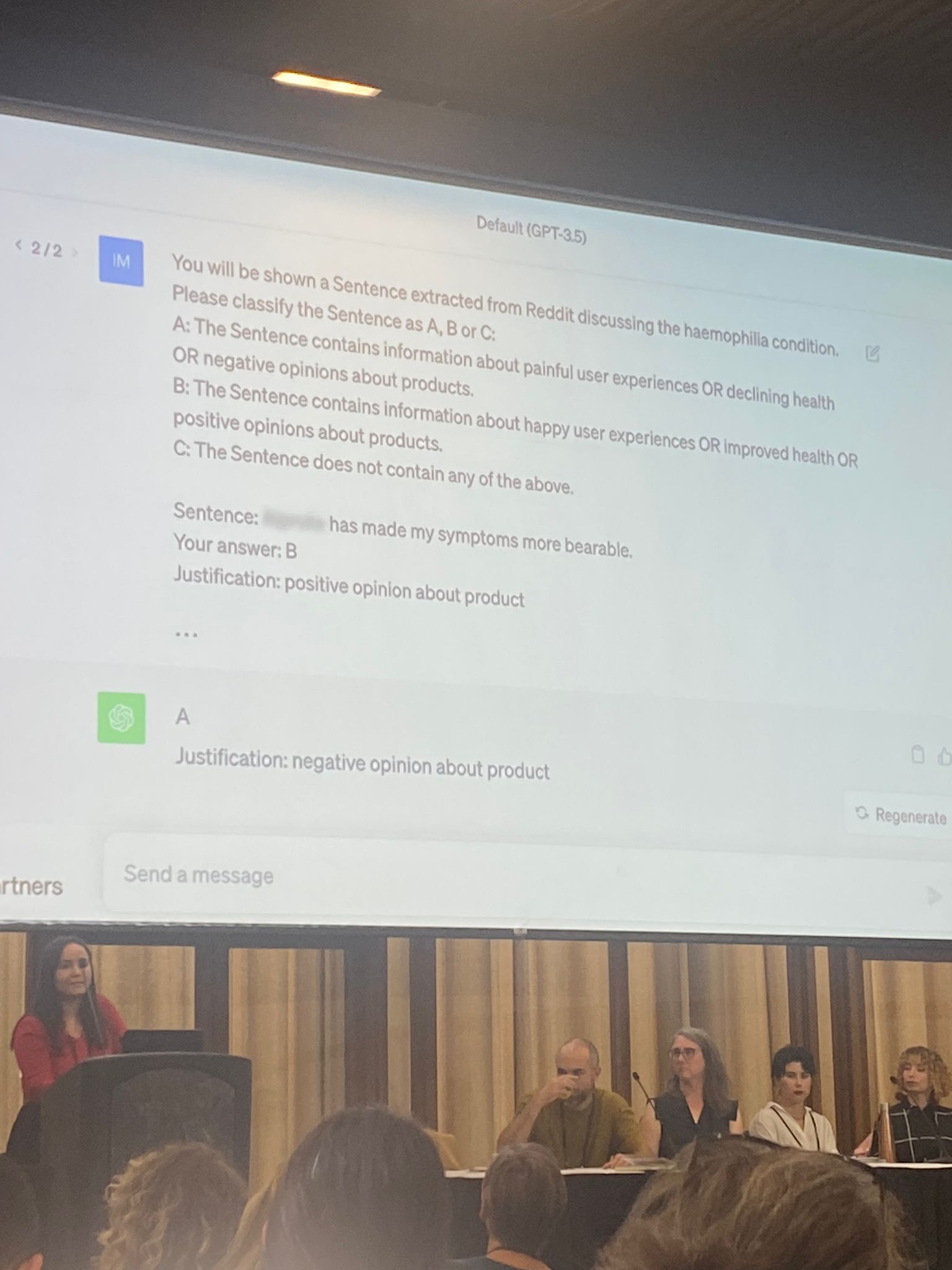
useful for sentiemnt analysis, topic modeling, semantic search, text summarization - large, low-context data sets
Can NLP alone predict why travel videos are valued from 40k comments? (can NLP replace primary research?)
But, in novel, uncharted spaces, the models can’t draw on relevant data. Leads to superficial findings. “symbol grounding problem”
“Text generated by an LLM is not grounded in communicative intent, any model of the world, or any model of the reader’s state of mind” Emily M. Bender et al, 2021e
The skills and expertise of ethnographers align very well with the gaps in capabilities of LLMs.
So, also did diary reesearch with people looking at those travel videos that NLP parsed comments of. These led insights such as one main Q viewers had when looking through the travel videos was affordability.
These Qs/insights then used to recode/reconfigure the LLM
complex truths can be translated to concrete signals within language (and without)
Framework for how this all could work:
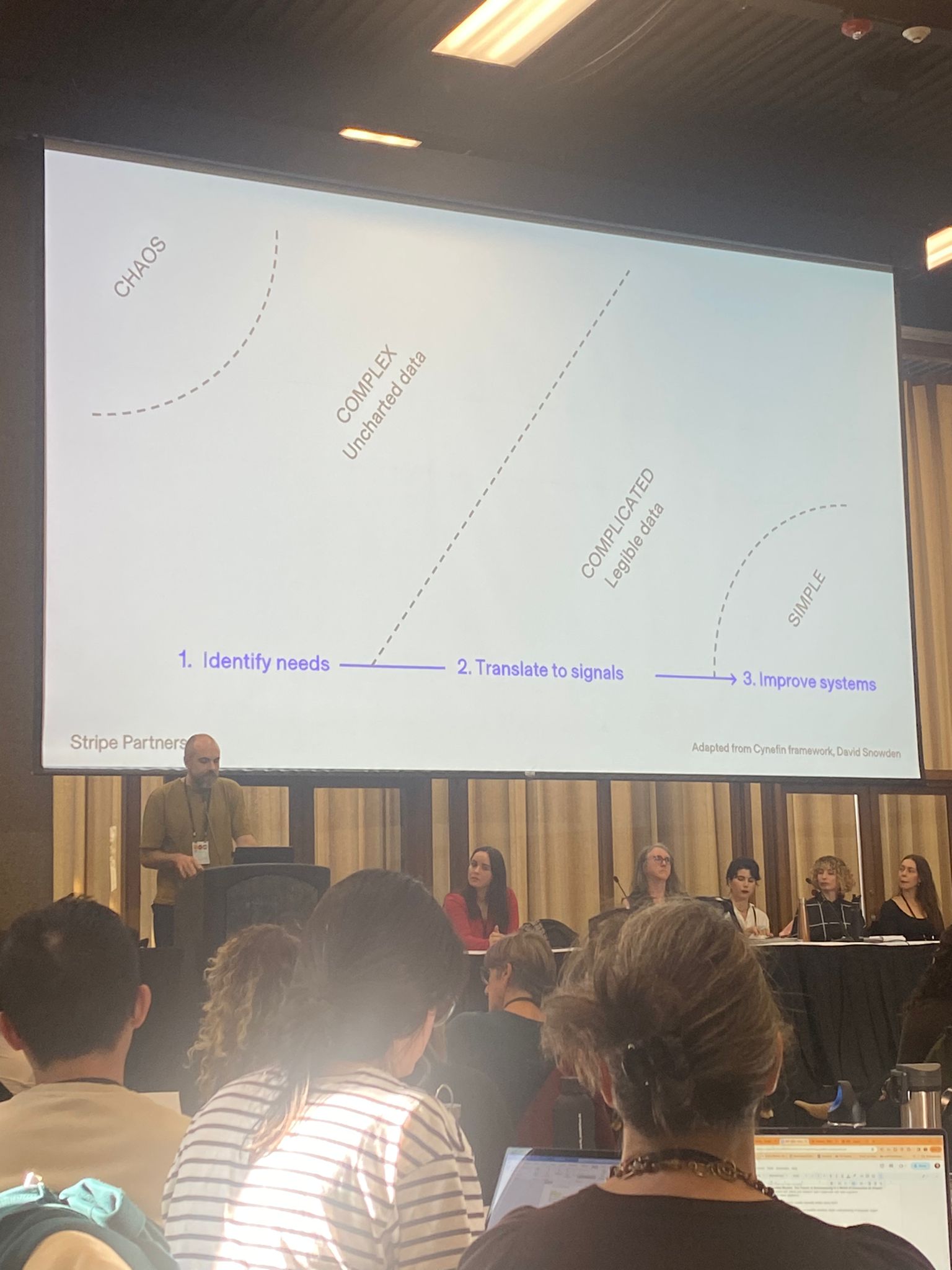
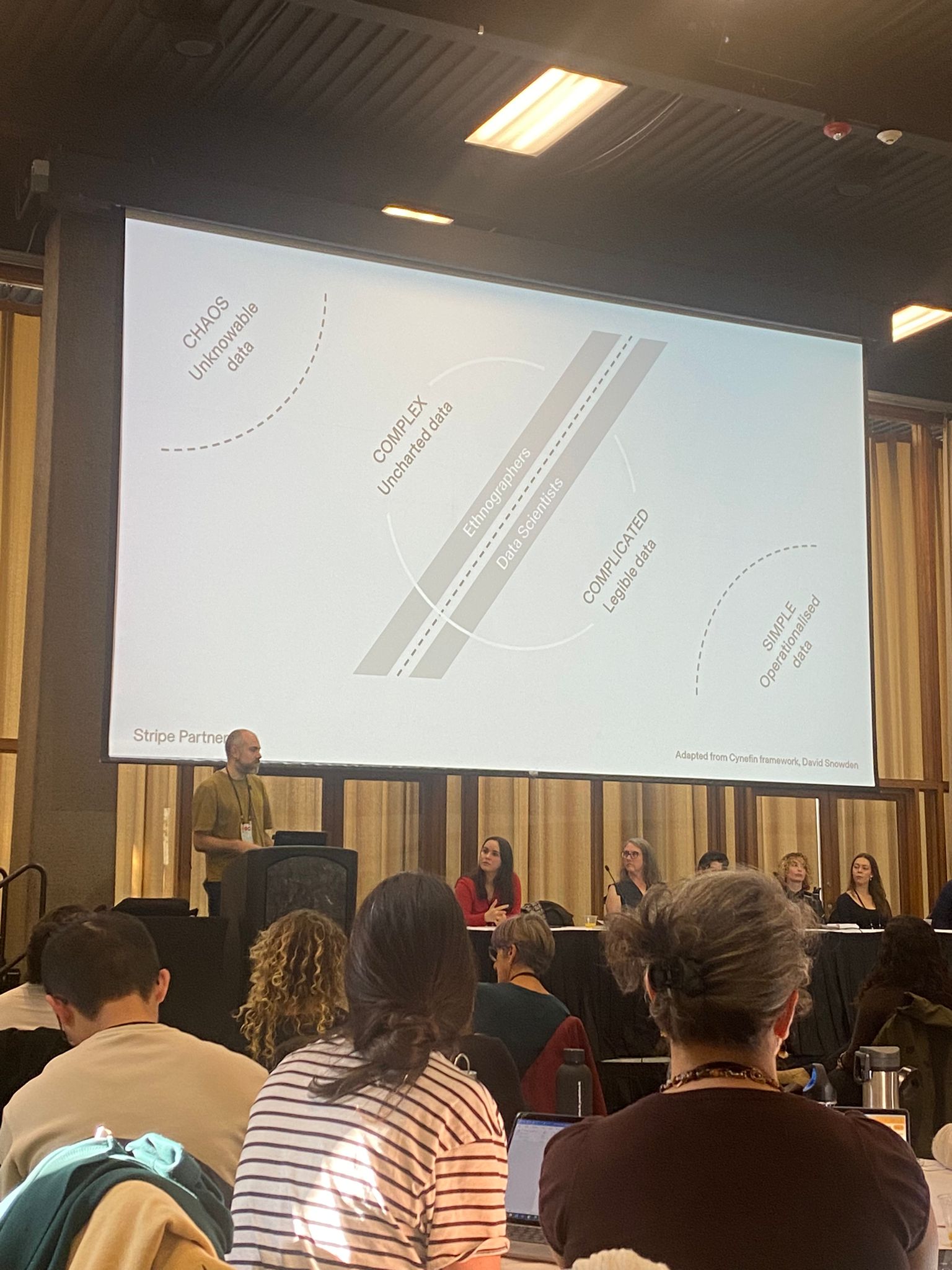
Complex worlds are the source of competitive advantage
Anticipation for Grand Challenges: An Ethnographic Study of Future-making Practices in a Technology Company (Paper)
Irem Tekogul, Institute of Design Illinois Institute of Technology (Presenter) Carlos Teixeira, Institute of Design Illinois Institute of Technology
Grand challenges:
- no clear solutions
- cannot be solved by easy fixes
- complex stakeholders
Visions & expectations: not just illustrate what could be, but informs what futures get made
Corporte foresight: org competence that enables anticipating changes. But to tackle grand challenges, we need to shift our attention beyond this
intersection of foresight and design could be a way to introduce future-making into company.
This company was undergoing transformation:
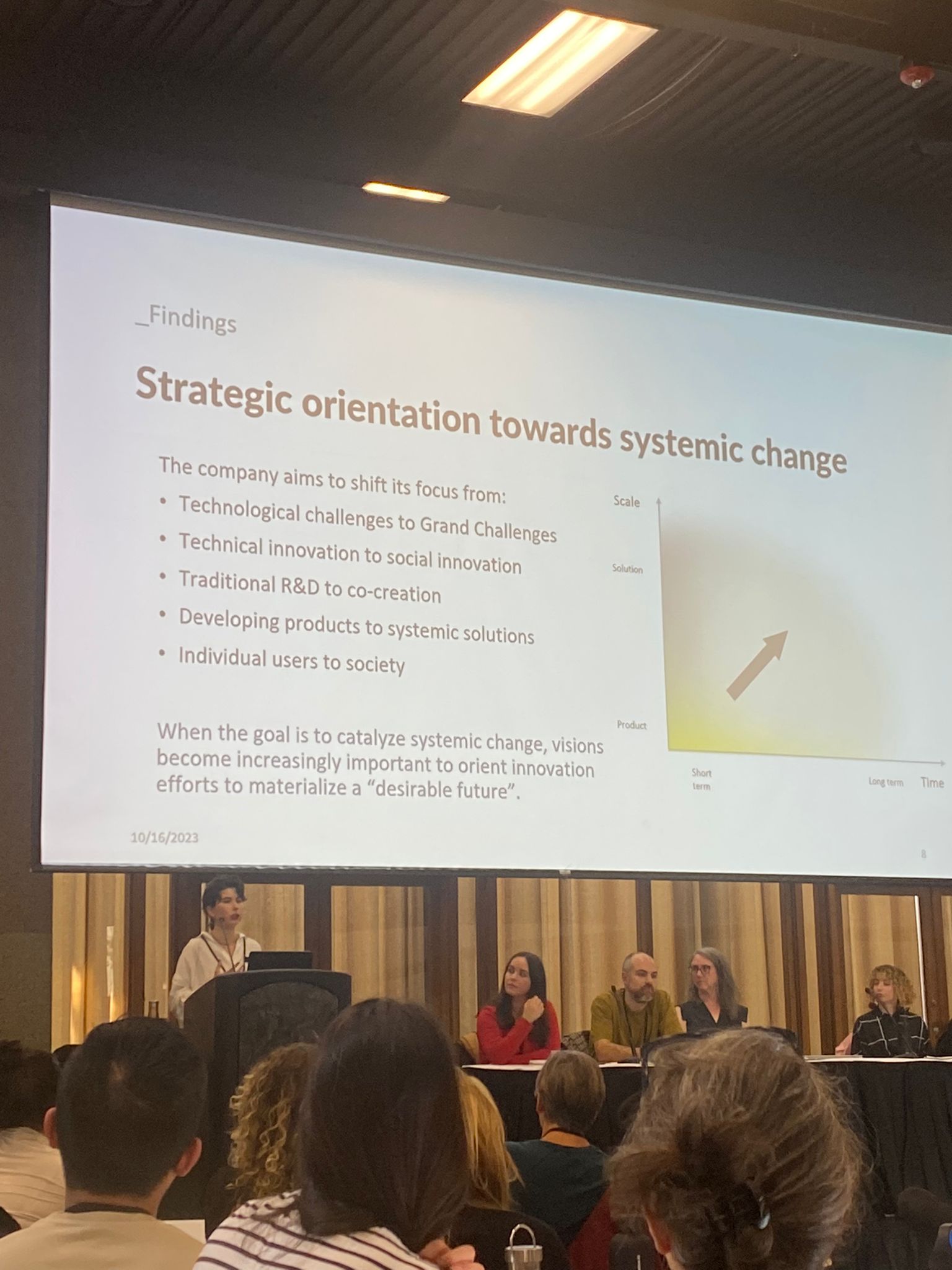
Futures thinking and foresight brought into the company through a process called “Prospection”
the process allowed for asking bigger questions, to step back, etc but also there were frictions in adoption:
- prospection as outcome or inquiry
- tension between vision (limited to scope of project) and Vision (long-term societal future)
- Futures-thinking as a highly technical skill vs distributed capacity.
Frictions in the Future of Work (Paper)
Madison Van Oort, Instacart (Presenter)
“Future of work” - floating signifier that lacks precise/concrete definition
also generally thought of in individualistic and techno-deterministic ways
we can introduce friction in this conversation by talking about relations
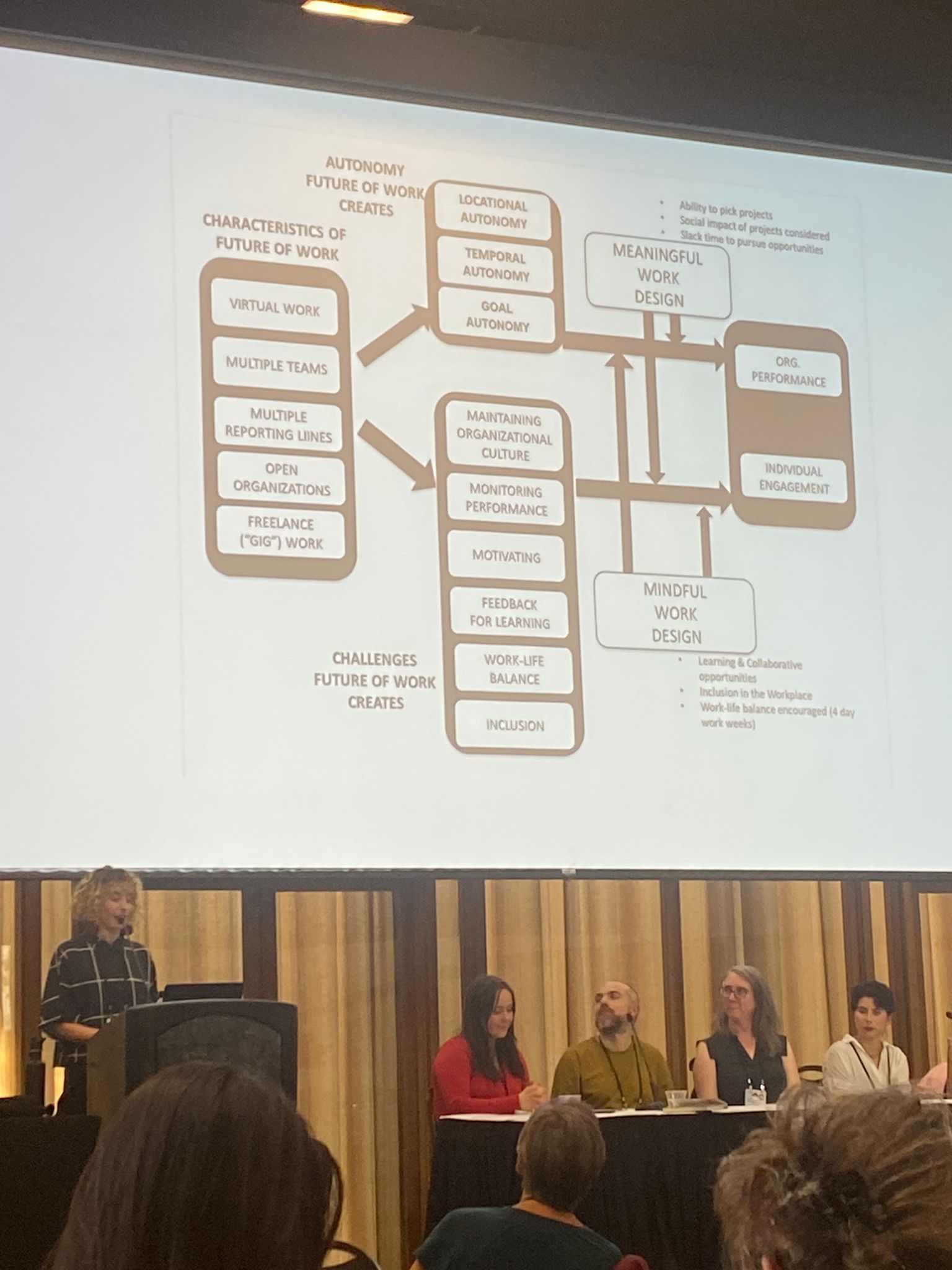
from that chart, in particular, monitoring performance can have a big impact on workers relation to their work
her research into future of work informed by pervious research into fast fashion. need to look back in time though to understand ‘monitoring performance’
Susan Porter Benson - Counter Cultures, about how counter ladies did their work and accumulated knowledge and how managers monitor them
The Managed Heart: Commercialization of Human Feeling - Arlie Russell Hochschild (coined the term emotional labour) - monitoring performance shifted to thrid parties (i.e. secret shoppers) rather than direct managerial oversight
Now: monitoring is done digitally instead of through analogue means.
Found a set of technologies that comes to the fore:
- automated scheduler. Shifted workforce from primarily full time to primarily part time. even zero-hour contracts/on call.
- biometric fingerprint scanners to clock in and out.
- POS surveillance for loss prevention.
front line workers knew they were being tracked but few understood the extent to which they’re tracked.
Some of the foundational frictions of capitalism has remained the same, but the social conditions have really transformed and ballooned.
Useful frameworks and tools:
- speculative design
- design justice
want to bring those togehter to create workers inquiry
Images and Imaginaries: Reflections on a New Paradigm of Ethnographic Images in Business (PechaKucha)
Enya Trenholm-Jensen, Gemic (Presenter)
80% of other sensory input is mediated by vision
what we capture and how we capture it evolves in tandem with technology
“The colonial gaze was disguised under the seemingly objective nature of photography”
we use stock photos as shortcuts in ethnography work i.e. to illustrate personas. But these have popularity bias.
Why not directly show respondents? Data privacy regulations prevent it.
trying to abide by regs to hide privacy risks dehumanizing the respondents
AI-generated images to the rescue…?
Friction between anonymity and authenticity
also slippery slope of generating ‘fakes’
there’s a possible future where these generated images do not replace but exist alongside documentation/photography
reopns age old debate about gaze and authenticity. who watches and who tells the story => who generates?
also has implications for future-ing/visioning work.
what do we stand to lose and gain when the lens becomes synthetic?
Fluidity and Friction: An Experiment in Ethnographic Foresight (PechaKucha)
Erin Duncan, Intuit (Presenter) Kat Lee, Intuit Ellie Michel, Intuit
had to create own foresight report - approached it by doing scrappy covert primary research
the best signals will always be things that people are actually doing.
We are living in a state of saturated ubiquity, colliding with impermanence.
this impacts personal identity formation, and sense of self that’s becoming more mutable
identity diversification is a survival strategy